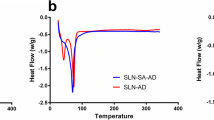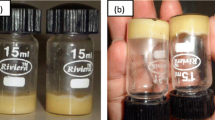Abstract
The present work focuses on the preparation and evaluation of lecithin organogel system of thermoreversible polymer pluronic F127, which would enhance the stability and absorption of sumatriptan succinate across the skin. Formulations were developed with and without co-surfactant (pluronic F127). The prepared organogels were evaluated for its appearance, organoleptic characteristics, and feel upon application, homogeneity, occlusivenes, washability, pH, viscosity, spreadability, gel transition temperature of formulations. The formulations were also evaluated for drug content, in vitro drug diffusion properties and skin irritation testing. In vivo evaluation of formulations was carried out by hot plate and writhing test method, and finally the optimized formulation was subjected to stability studies. The developed formulations were easily washable, smooth in feel, and showed no clogging which indicate superior texture of system. Formulation, containing pluronic showed greater spreadability and higher drug diffusion rate as compared to pluronic free organogel. Drug content of organogel formulations was in the range of 94–97%. The pH of the formulations was 6.48 ± 0.5 and 6.98 ± 0.1, reflecting no risk of skin irritation. Pluronic not only enhances the stability of organogel by increasing the viscosity (from 6,541 ± 234.76 to 7,826 ± 155.65 poise) but also increases the release of drug from 67.39 ± 1.53% to 74.21 ± 1.7%. The sumatriptan exhibits higher and long lasting antinociceptive effect as indicated by the persistent increase in reaction time in hot plate and inhibited abdominal contraction in acetic acid-induced writhing test (p < 0.05). The prepared optimized formulation was found to be stable without any significant changes at room temperature.


Similar content being viewed by others
REFERENCES
Hermans PH. Gels. In: Kruyt HR, editor. Colloid science (volume 2). Amsterdam, The Nederlands: Elsevier; 1949. p. 483–651.
Flory PJ. Introductory lecture. Disc Faraday Soc. 1974;57:7–18.
Almdal K. Towards a phenomenological definition of the term gel. Polym Gels Netw. 1993;1:5–17.
Abdallah DJ, Lu L, Weiss RG. Thermoreversible organogels from alkane gelators with one heteroatom. Chem Mater. 1999;11:2907–11.
Abdallah DJ, Weiss RG. n-Alkanes gel n-alkanes (an many other organic liquids). Langmuir. 2000;16:352–5.
Capitani D, Segre AL, Dreher F, Walde P, Luisi PL. Multinuclear NMR investigation of phosphatidylcholine organogels. J Phys Chem. 1996;100:15211Y15217.
Walde P, Giuliani AM, Boicelli CA, Luisi PL. Phospholipid-based reverse micelles. Chem Phys Lipids. 1990;53:265Y288.
Shumilina EV, Khromova Y, Shchipunov YA. A study of the structure of lecithin organic gels by Fourier-transform IR spectroscopy. Zh Fiz Khim. 2000;74:1210Y1219.
Shchipunov YA, Duressschmidt T, Hoffmann H. Electrorheological effects in lecithin organogels with water and glycerol. J Colloid Interface Sci. 1990;212:390–401.
Shchipunov YA. Lecithin organogel: a micellar system with unique properties. Colloids surf A Physicochem Eng Asp. 2001;183–185:541–54.
Shchipunov YA. Lecithin organogel: rheological properties of polymer-like micelles formed in the presence of water. Colloid J. 1995;57:556–60.
Shchipunov YA, Duressschmidt T, Hoffmann H. End to end fusion of polymer-like micelles in the lecithin organogel under the action of an electric field. Langmuir. 2000;16:297–9.
Shchipunov YA, Shumilina EV. Lecithin bridging by hydrogen bonds in the organogel. Mater Sci Eng C. 1995;3 Suppl 1:43.
Shchipunov YA, Shumilina EV. Molecular model for the lecithin self-organization into polymer-like micelles. Prog Colloid Polym Sci. 1997;106 Suppl 1:228.
Wessman M, Gisela M. Migraine: a complex genetic disorder. Lancet Neurol. 2007;6:521–32.
The Headache Classification Committee of the International Headache Society. The international classification of headache disorders: 2nd edition. Cephalalgia. 2004;24 Suppl 1:160.
Villalon CM, Centurion D, Valdivia LF, De Varis P, Saxena PR. Migraine: pathophysiology, pharmacology treatment and future trends. Curr Vasc Pharmacol. 2003;1:71–84.
Humphrey PP, Feniuk W, Marriott AS, Tanner RJ, Jackson MR, Tucker ML. Preclinical studies on antimigrine drugs. Eur Neurol. 1991;31:282–90.
Jhee SS, Shiovitz T, Crawford AW, Cutler NR. Pharmacokinetics and pharmacodynamics of the triptan antimigraine agents: a comparative review. Clin Pharmacokinet. 2001;40:189–205.
Upadhyay KK, Tiwari C, Khopade AJ, Bohidar HB, Jain SK. Sorbitan Ester organogels for transdermal delivery of sumatriptan. Drug Dev Ind Pharm. 2007;33:617–25.
Goadsby PJ, Lipton RB, Ferrari MD. Migraine: current understanding and treatment. N Engl J Med. 2002;346:257–70.
Aurora SK, Kori SH, Barrodale P, McDonald SA, Haseley D. Gastric stasis in migraine: more than just a paroxysmal abnormality during a migraine attack. Headache. 2006;46:57–63.
Pierce M, Marbury T, Neill CO, Siegel S, Du W, Sebree T. Zelrix™: a novel transdermal formulation of sumatriptan. Headache. 2009;49:817–25.
Siegel SJ, Neill CO, Dube LM, Kaldeway P, Morris R, Jackson D, et al. Aunique iontophoretic patch for optimal transdermal delivery of sumatriptan. Pharm Res. 2007;24:1919–26.
Bhatia A, Singh B, Amarji B, Katare OP. Tamoxifen-Loaded liposomal topical formulation arrests hair growth in mice. Br J Dermatol Nurs. 2009. doi:10.1111/j.1365-2133.2010.09880.x.
Gupta M, Goyal AK, Paliwal SR, Paliwal R, Mishra N, Vaidya B, et al. Development and characterization of effective topical liposomal system for localized treatment of cutaneous candiasis. J Liposome Res. 2010;20(4):341–50.
Dragicevic-Curic N, Winter S, Krajisnik D, Stupar M, Milic J, Graefe S, et al. Stability evaluation of temoporfin-loaded liposomal gels for topical application. J Liposome Res. 2010;20(1):38–48.
Puglia C, Filosa R, Peduto A, de Caprariis P, Rizza L, Bonina F, et al. Evaluation of alternative strategies to optimize ketorolac transdermal delivery. AAPS PharmSciTech. 2006;7(3):E1–9. doi:10.1208/pt070364. Article 64.
Ferderber K, Hook S, Rades T. Phosphatidyl choline-based colloidal systems for dermal and transdermal drug delivery. J Liposome Res. 2009;19(4):267–77.
Luciana BL, Hillary VDW, Hsin TL, Vijay V, Hsin KL, Stan N, et al. Topical delivery of lycopene using microemulsions: enhanced skin penetration and tissue antioxidant activity. J Pharm Sci. 2009;99(3):1346–57.
Scalia S, Mezzena M, Iannuccelli V. Influence of solid lipid microparticle carriers on skin penetration of the sunscreen agent, 4-methylbenzylidene camphor. J Pharm Pharmacol. 2007;59:1621–7.
Jain SK, Gupta Y, Jain A, Rai K. Enhanced transdermal delivery of acyclovir sodium via elastic liposomes. Drug Deliv. 2006;15:141–7.
Maestrelli F, Capasso G, González-Rodríguez ML, Antonio M, Rabasco CG, Mura P. Effect of preparation technique on the properties and in vivo efficacy of benzocaine-loaded ethosomes. J Liposome Res. 2009;19(4):253–60.
Bendas ER, Tadros MI. Enhanced Transdermal Delivery of Salbutamol Sulfate via Ethosomes. AAPS PharmSciTech 2007; 8 (4) Article 107
Bender J, Simonsson C, Smedh M, Engström S, Ericson MB. Lipid cubic phases in topical drug delivery: visualization of skin distribution using two-photon microscopy. J Control Release. 2008;129(3):163–9.
Bender J, Ericson MB, Merclin N, Iani V, Rosen A, Engstrom S, et al. Lipid cubic phases for improved topical drug delivery in photodynamic therapy. J Control Release. 2005;106:350–60.
de Jalon EG, Blanco-Prıeto MJ, Ygartua P, Santoyo S. Topical application of acyclovir-loaded microparticles: quantification of the drug in porcine skin layers. J Control Release. 2001;75:191–7.
de Jalon EG, Blanco-Prıeto MJ, Ygartua P, Santoyo S. PLGA microparticles: possible vehicles for topical drug delivery. I J Pharm. 2001;226:181–4.
Santoyo S, de Jalon EG, Ygartua P, Renedo MJ, Blanco-Prıeto MJ. Optimization of topical cidofovir penetration using microparticles. I J Pharm. 2002;242:107–13.
Amrutiya N, Bajaj A, Madan M. Development of microsponges for topical delivery of mupirocin. AAPS PharmSciTech. 2009;10(2):402–9.
Haddadi A, Aboofazeli R, Erfan M, Farboud ES. Topical delivery of urea encapsulated in biodegradable PLGA microparticles: O/W and W/O creams. J Microencapsul. 2008;25(6):379–86.
Shim J, Kang HS, Won-Seok P, Sang-Hun H, Kim J, Ih-Seop C. Transdermal delivery of mixnoxidil with block copolymer nanoparticles. J Control Release. 2004;97:477–84.
Alvarez-Roman R, Naik A, Kalia YN, Guy RH, Fessi H. Enhancement of topical delivery from biodegradable nanoparticles. Pharm Res. 2004;21(10):1818–25.
Rancan F, Papakostas D, Hadam S, Hackbarth S, Delair T, Primard C, et al. Investigation of polylactic acid (PLA) nanoparticles as drug delivery systems for local dermatotherapy. Pharm Res. 2009;26(8):2027–36.
Pandey M, Belgamwar V, Gattani S, Surana S, Tekade A. Pluronic lecithin organogel as a topical drug delivery system. Drug Deliv. 2010;17(1):38–47. doi:10.3109/10717540903508961.
Dhiman M, Yedurkar P, Sawant KK. Formulation, characterization, and in vitro evaluation of bioadhesive gels containing 5-fluorouracil. Pharm Dev Technol. 2008;13(1):15–25.
Naik A, Kalia YN, Guy RH. Transdermal drug delivery: overcoming the skin’s barrier function. Pharm Sci Technol Today. 2000;3:318–26.
Idson B, Lazarus J. Semisolids. In: The theory and practice of industrial pharmacy. Bombay, India: Vargehese Publishing House; 1991. p. 534–63.
Escobar-Chávez JJ, López-Cervantes M, Naïk A, Kalia YN, Quintanar-Guerrero D, Ganem-Quintanar A. Applications of thermoreversible pluronic f-127 gels in pharmaceutical formulations. J Pharm Pharmaceut Sci. 2006;9(3):339–58.
Murdan S. A review of pluronic lecithin organogel as a topical and transdermal drug delivery system. Hosp Pharm. 2005;12:267–70.
Kumar R, Katare OP. Lecithin organogels as a potential phospholipid-structured system for topical drug delivery: a review. AAPS PharmSciTech. 2005;06 Suppl 02:E298–310.
Nasseri AA, Aboofazeli R, Zia H, Needham TE. Lecithin stabilized microemulsion: an organogel for topical application of ketorolac tromethamine I: phase behavior studies. Iran J Pharm Res. 2003;2:59–61.
Shchipunov YA, Shumilina EV. Lecithin organogels: role of polar solvent and nature of intermolecular interactions. Colloid J. 1996;58:117–25.
Willimann H, Walde P, Luisi PL, Gazzaniga A, Stroppolo F. Lecithin organogel as matrix for transdermal transport of drugs. J Pharm Sci. 1992;81:871–4.
Anand B. Applications of organogels in pharmaceuticals. J Sci Ind Res. 2001;60 Suppl 4:311–8.
Suh H, Jun HW. Physicochemical and release studies of naproxen in poloxamer gels. Int J Pharm. 1996;129:13–20.
Ghelardini C, Galeotti N, Figini M, Imperato A, Nicolodi M, Sicuteri F, et al. The central cholinergic system has a role in the Antinociception induced in rodents by anti migraine drug sumatriptan. J Pharmacol Ther. 1996;279:884–90.
Rohit, Rao C, Krishna G. Effect of captopril and losartan on thermal and chemical induced pain in mice. Indian J Physiol Pharmacol. 2006;50 Suppl 2:169–74.
Kulkarni SK, Jain NK. Pharmacological and pharmacokinetics studies on marketed gel formulations of nimesulide. Indian Drugs. 2001;38 Suppl 2:63–6.
ACKNOWLEDGMENTS
The authors would like to acknowledge Aurobindo Pharmaceutical Ltd. Hyderabad (India), for providing free gift sample of sumatriptan succinate. The authors are very thankful to the management of School of Pharmaceutical Sciences, Rajiv Gandhi Technical University, for providing necessary facilities and encouragement. Authors are also thankful to Head, Department of Pharmaceutical Sciences, IPS Academy, Indore (India) for providing facilities for in vivo animal studies.
Author information
Authors and Affiliations
Corresponding author
Rights and permissions
About this article
Cite this article
Agrawal, V., Gupta, V., Ramteke, S. et al. Preparation and Evaluation of Tubular Micelles of Pluronic Lecithin Organogel for Transdermal Delivery of Sumatriptan. AAPS PharmSciTech 11, 1718–1725 (2010). https://doi.org/10.1208/s12249-010-9540-7
Received:
Accepted:
Published:
Issue Date:
DOI: https://doi.org/10.1208/s12249-010-9540-7




